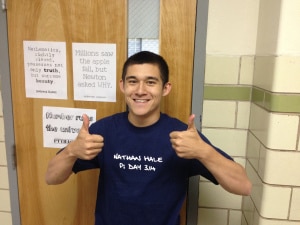In this latest alumni spotlight, BA in WRD alumnus Colin Sato shares about his experiences as a high school math teacher.
What have you been doing professionally or since you earned your degree?
About 8 hours after I turned in my last final, I was on a plane to Tulsa to begin training with Teach for America to be a high school math teacher. I’ve been teaching mathematics to the students at Nathan Hale High School in Tulsa ever since. Since then, I have taught every math class offered at the school: algebra 1 and 2, geometry, pre-calc, and AP calculus (which is my love). I also just finished a computer science teaching fellowship with the Flatiron School in New York City.
What is a typical day “on the job” for you?
I teach at a school with curious, motivated, intelligent students who also happen to come from low-income households. Because of this, my role as teacher oscillates rapidly between content deliverer, crisis counselor, Spanish translator, cheerleader, life coach, tutor, etc. I also started a number of after school activities at our school like a math club, a computer programming club that collaborates with a local web developers group, math support groups for English and Spanish speaking parents, and a Saturday school program. There is rarely a typical day, which is great.
How did your education from DePaul influence what you’re doing now?
Learning is sometimes thought of as breaking knowledge into disciplines and then attaining degrees in those disciplines. So much so, that many people seem to have the impression that knowledge itself is like that! The WRD and philosophy departments especially helped me to see the broad interconnectedness of academic disciplines as different modes of questioning suited to different types of questions. It’s been my experience that students (and all people) like to see knowledge this way: they enjoy seeing how mathematics, science, art, history, and philosophy form a kind of fabric in which mathematical truth is woven.
What were the most helpful courses you took in WRD?
History of Literacy exposed me to the idea that writing is a technology, which gave me a similar epiphany about mathematics and the scientific method. It also helped me to understand the interconnection between symbolic systems and the societies they grow up in.
Semiotics was the first time that I was able to see almost all human activity as unified under one theoretical umbrella. It was great.
Writing Center Theory and Pedagogy forced me to acknowledge that I really love helping people to learn. At this point, I’ve thoroughly given in to that love.
What advice would you give to a WRD student who would one day like to work in job like yours?
Education generally and the teaching profession specifically need radical thinkers with backbones. For teachers, I would suggest learning the difference between the discourse you are teaching as it is practiced by professionals and the discourse you are teaching as it is construed in school. For me, this meant finding an enormous chasm that had the poetry of reason (math as it really is) on one side, and drill and kill (math as it’s usually taught) on the oth—ah, I must go. Time to build a bridge.
